Child Maintenance Service statistics: data to March 2020 (experimental)
Published 24 June 2020
The latest release of these statistics can be found in the collection of Child Maintenance Service statistics.
This release of statistics on the Child Maintenance Service is for January 2015 and March 2020. The release includes revisions to previously published statistics.
The next release is planned for September 2020.
1. Introduction
The Child Maintenance Service was introduced in December 2012 as part of the government’s Child Maintenance reforms. It replaced the Child Support Agency (CSA) and is for separated parents who cannot arrange child maintenance between themselves.
Direct Pay is where the Child Maintenance Service calculates the amount of maintenance to be paid and parents arrange the payments between themselves.
If parents cannot do this or they do not pay what was agreed, then the Child Maintenance Service can collect and manage the payments between the parents. This is the Collect and Pay service.
The Child Maintenance Service has a range of enforcement actions it can use if the Paying Parent refuses to pay their child maintenance.
2. Main stories
Figure 1: 737,600 children are covered by Child Maintenance Service arrangements

Chart shows 471,700 children were covered by Direct Pay and 261,200 children were covered by Collect and Pay for the quarter March 2020. 737,600 children were covered by both arrangements. This figure has steadily increased since December 2017
Source: Child Maintenance Service statistics data to March 2020, national tables, table 5.
There are:
- 471,700 children covered through Direct Pay arrangements
- 261,200 children covered through the Collect and Pay Service
- 4,800 children not yet assigned to a service (not shown in chart)
The number of children covered by the Direct Pay service has increased by 14,100 since the previous quarter.
Figure 2: Compliance on the Collect and Pay service is at 68%

Chart shows Paying Parents compliance rate was 68% for the quarter March 2020. This has been increasing since the quarter December 2017. However, the sustained rate of improvement observed in this metric during 2018 and early 2019 has now levelled off
Source: Child Maintenance Service statistics data to March 2020, national tables, table 8.
68% of parents due to pay child maintenance through the Collect and Pay service paid some maintenance in the quarter ending March 2020.
The Collect and Pay service is largely composed of individuals that transferred from the Direct Pay service, after failing to pay their liabilities.
The sustained rate of improvement observed in this metric during 2018 and early 2019 has now levelled off.
Effect of Coronavirus (COVID-19)
This publication covers data up to the end of March 2020. During the final weeks of this period, the Child Maintenance Service was affected by the Coronavirus (COVID-19) outbreak and the resultant changes to the department’s operational priorities. However, the timing of the outbreak (late in the quarter) means that the impact on the figures below appears to be minimal. We expect that the impact will be clearly manifest in the statistics for subsequent quarters.
3. What you need to know
Child maintenance is financial support between separated parents to help with the everyday costs of looking after children.
If they agree, separated parents can arrange child maintenance themselves. This is called a ‘family-based arrangement’ and is a private way to sort out child maintenance. Parents arrange everything themselves and no-one else has to be involved.
The Child Maintenance Service, which replaced the Child Support Agency (CSA), is for when parents cannot agree to a family-based arrangement. Parents wishing to use the Child Maintenance Service must first contact Child Maintenance Options (CM Options).
CM Options is a free service that provides impartial information and support to help separated parents make decisions about their child maintenance arrangements.
Figure 3: Outcomes of calls made to CM Options between May and July 2019

Chart shows that between May and July 2019 44,800 people spoke with Options. 65% went on to set up a Child Maintenance Service Arrangement, 18% went on to set up a Family-based Arrangement and 16% went on to set up No Arrangement or other
Source: Child maintenance arrangements made after speaking to CM Options May 2020, table 1.
Read information on child maintenance arrangements made after speaking to CM Options.
Definitions
Receiving Parent
The Receiving Parent has the main day-to-day care of the children and receives the child maintenance.
Paying Parent
The Paying Parent does not have the main day-to-day care of the children and pays child maintenance.
Children covered
Children covered is the number of children for whom the Paying Parent has a child maintenance arrangement.
Compliance
Compliance is where parents using the Collect and Pay service have paid some child maintenance in the last three months.
See the Background Information document for more details.
4. Applications to the Child Maintenance Service
Parents who want to apply to the Child Maintenance Service must pay a £20 application fee. Parents do not have to pay this if they:
- have been a victim of domestic abuse
- declare their child has been the victim of abuse
- are under 19 years of age
Some applications to the Child Maintenance Service are from parents who previously had an arrangement with the Child Support Agency.
All Child Support Agency cases with an ongoing liability were closed by December 2018, and parents were encouraged to make a new family-based arrangement or an arrangement through the Child Maintenance Service. However, the Child Maintenance Service may still receive applications from such parents, as they may have had a family-based arrangement in the interim.
Figure 4: The number of new arrangements joining the Child Maintenance Service has seen a marginal increase this quarter

Chart shows for the quarter March 2020 416,700 children were covered by Direct Pay, 149,400 were covered by Collect and Pay where some maintenance was paid, 111,700 were covered by Collect and Pay were no maintenance was paid
Source: Child Maintenance Service statistics data to March 2020, national tables, table 3.
Throughout 2019, the rate of applications joining the service continued to decline in line with the downward trend. However, in the last quarter, ending March 2020, the intake increased marginally to 19,700 which is in line with previous seasonal trends.
At the end of March 2020, the Child Maintenance Service was managing 515,600 arrangements for 483,800 Paying Parents. This is a 9% increase to the number of arrangements since the end of March 2019.
See tables 1-3 and 7 of the national tables for more information.
See Stat-Xplore for more information on arrangements.
5. Composition of cases on the Child Maintenance Service
When a parent makes an application to the Child Maintenance Service, they will be told how much child maintenance should be paid.
Some parents will then arrange the payments between themselves: this service is known as Direct Pay. Parents are issued a text message 3 months after they set up a Direct Pay arrangement, and at each annual review, to check that the arrangement is still meeting their requirements.
If parents cannot arrange payments between themselves, or if the Paying Parent does not keep up with the payments, the Receiving Parent can ask the Child Maintenance Service to switch the case to the Collect and Pay service.
This service collects and manages payments between the parents, including recovery of unpaid maintenance that built up under the Direct Pay service.
This could involve the use of enforcement powers. To use the Collect and Pay service, Paying Parents are charged 20% of their child maintenance, and Receiving Parents 4%. This is intended to encourage parents to collaborate.
Figure 5: Flow of arrangements on the Child Maintenance Service during the quarter ending March 2020

Chart shows the flow of arrangements around the Child Maintenance Service in the quarter March 2020. The main flows seen were 15,300 New Applications to Direct Pay, 9,000 moved from Direct Pay to Collect and Pay and a further 7,300 cases Closed
Source: Child Maintenance Service statistics data to March 2020, national tables, table 4.
Each box on Figure 5 shows the number, and percentage, of arrangements using that service type at the end of the quarter. Percentages may not sum to 100% due to rounding. Arrows represent the number of cases that moved between service types during the quarter. The largest flows (over 5,000 cases) are in bold. Some smaller flows are excluded from this diagram, but can be found in table 4 of the national tables.
Arrangements may not be assigned to a service type for a short period following application. In response to the COVID-19 outbreak, outstanding work and resources, including the progress of new applications, needed to be re-prioritised, resulting in an increase in the number of arrangements not yet assigned to a service type. It is anticipated this will continue to increase until recovery action begins.
Figure 5 shows:
- most new applicants choose to start on Direct Pay: 15,300 new applicants joined Direct Pay during the quarter ending March 2020
- 63% of all Child Maintenance Service arrangements use Direct Pay, with 37% using Collect and Pay
- more parents move from Direct Pay to Collect and Pay than the other way around: 9,000 parents switched to Collect and Pay during this quarter
- more arrangements joined the service than left: the number of arrangements increased by 9,700 during this quarter
See table 4 of the national tables for more information.
See Stat-Xplore for more information on arrangements.
6. Children covered by the Child Maintenance Service
Figure 6: Children covered by Child Maintenance Service arrangements, March 2018 to March 2020

Chart shows for the quarter March 2020 416,700 children were covered by Direct Pay, 149,400 were covered by Collect and Pay where some maintenance was paid, 111,700 were covered by Collect and Pay were no maintenance was paid
Source: Child Maintenance Service statistics data to March 2020, national tables, table 5.
For presentational reasons, a small number of children, who are covered by arrangements not assigned to a service type, have been excluded from this chart. The chart includes at least 99% of children covered by the Child Maintenance Service for all calendar quarters shown.
At the end of March 2020:
- 471,700 children were covered by 322,900 Direct Pay arrangements
- 261,200 children were covered by 189,300 arrangements through the Collect and Pay service
- 149,400 of these children were covered by 105,100 Collect and Pay arrangements where the Paying Parent paid some maintenance during the quarter
64% of all children covered by Child Maintenance Service are covered through Direct Pay arrangements, with 20% covered by Collect and Pay arrangements for which some maintenance was paid in the quarter. These proportions have changed little over the last 12 months (66% and 19% respectively in March 2019).
See table 5 of the national tables for more information.
7. Paying Parents and the Collect and Pay service
This includes Paying Parents transferred from the Direct Pay service because they have failed to keep up with payments.
Figure 7: Compliance rate of Paying Parents due to pay maintenance through the Collect and Pay service, quarters ending March 2018 to March 2020

Chart shows that 100,200 Paying Parent cleared some of their child maintenance through Collect and Pay service for the quarter March 2020.This was 68% of all paying parents due to pay child maintenance through the Collect & Pay service in that quarter
Source: Child Maintenance Service statistics data to March 2020, national tables, table 8.
In the quarter ending March 2020, 100,200 Paying Parents cleared some of their child maintenance through the Collect and Pay service. This was 68% of all Paying Parents due to pay child maintenance through the Collect & Pay service in that quarter.
The compliance rate has remained at a stable level over the last year to March 2020.
See table 8 of the national tables for more information.
8. Child Maintenance due and paid
The Child Maintenance Service monitors payments made through the Collect and Pay service and can take enforcement action where necessary.
Parents on Direct Pay with unpaid maintenance owed will first have to transfer to Collect and Pay before the Child Maintenance Service can take any action. This means the Collect and Pay service consists of a subset of Paying Parents who are less likely to pay.
Figure 8: Child Maintenance due and paid each quarter, quarters ending March 2018 to March 2020

Chart shows £197.9 million was due to be paid through Direct Pay, £45.2 million was paid by Collect and Pay and £19.3 million was unpaid maintenance through Collect and Pay for the quarter March 2020
Source: Child Maintenance Service statistics data to March 2020, national tables, table 9.
As a result of problems with data feeds, the figures in this chart for the quarter ending December 2018 are estimates. More detail about this is available in the background information document.
During the quarter ending March 2020, £262.4 million Child Maintenance was due to be paid.
£243.1 million was paid through the Collect and Pay service or due to be paid through Direct Pay arrangements:
- £197.9 million due to be paid through Direct Pay arrangements
- £45.2 million paid through the Collect and Pay service
Over the long term, the amount of money due to be paid through the Child Maintenance Service has been rising as the number of parents using the service has increased.
£19.3 million of maintenance due to be paid through the Collect and Pay service in the quarter ending March 2020 was not paid.
Since 2012, when the Child Maintenance Service began, £354.2 million in unpaid maintenance is owed through the Collect and Pay service. This amounts to 10% of all maintenance due to be paid since the start of the service and includes unpaid maintenance transferred from Direct Pay to Collect and Pay.
See tables 9 and 10 of the national tables for more information.
9. Enforcement
When a payment is missed, the Child Maintenance Service contacts the Paying Parent to arrange a recovery of what is owed or to make clear the actions that may be pursued in the absence of a payment.
For parents on Collect and Pay, enforcement is automatically pursued on their behalf.
For parents on Direct Pay (where the receiving parent asks the Child Maintenance Service to take action) the arrangement is first switched to the Collect and Pay service before any enforcement action can commence.
The Child Maintenance Service can collect unpaid child maintenance in 3 major ways:
-
deduction from earnings order or request – money is recovered from the paying parent’s earnings via their employer, who will be instructed on the amount to deduct
-
deduction order – money is deducted directly from the paying parent’s bank or building society account
-
courts – a paying parent can be taken to court over unpaid maintenance
The courts can grant liability orders, which allow further action to be taken, such as referral to enforcement agents, who can seize goods and sell them to cover any unpaid maintenance and costs.
Where the paying parent is a homeowner, courts may grant a charging order against the property, which prevents any sale without repayment of the outstanding amount.
Ultimately, the court may grant an order for sale which forces the sale of the property. If these methods are unsuccessful, the Child Maintenance Service may apply for the courts to:
-
disqualify the parent from holding or obtaining a driving licence
-
disqualify the parent from holding or obtaining a passport
-
send the parent to prison
Figure 9: Enforcement actions taking place, quarters ending March 2018 to March 2020

Chart shows that in the quarter March 2020 there were 49,200 Deductions from Earning Orders and Requests, 3,700 Liability Orders in process, 4,500 Enforcement Agent Referrals in process and 3,600 Regular and Lump Sum Deduction Orders in process
Source: Child Maintenance Service statistics data to March 2020, national tables, table 11.1.
At the end of March 2020:
-
49,200 deductions from earnings orders and requests were in place
-
3,700 liability orders were in process
-
4,500 enforcement agent referrals were in process
-
3,600 regular and lump sum deduction orders were in process
See tables 11.1 and 11.2 of the national tables for more information.
10. About these statistics
Comparisons
Comparisons between these statistics on the Child Maintenance Service and statistics on the Child Support Agency should not be made as the 2 services have different aims and cover different groups.
The government’s changes to the child maintenance system in 2012 were designed to encourage parents to work together to provide for their children. Child Maintenance Options was created to support parents to set up collaborative, family-based arrangement. The Child Maintenance Service was intended for those parents who cannot make family-based arrangements.
Rounding
Figures contained within this publication are rounded to the nearest hundred, percent, or £100,000. Percentages are calculated prior to rounding.
These statistics have been developed using guidelines set out by the UK Statistics Authority.
Changes made to this publication
Stat-Xplore
We have moved data at arrangement level over to the Department for Work and Pensions StatXplore tool. This tool allows users to create custom statistical tables relating to arrangements on the Child Maintenance Service.
Subsequently the following changes have occurred:
-
Table Numbers – due to the removal of a table, please be aware that some table numbers have changed.
-
The number of Paying Parents and their Child Maintenance Arrangements (formerly Table 4) – This table has been removed from the National Tables, as arrangements data is now available on Stat-Xplore. Information on the number of Paying Parents is available in Table 7 (“How much Child Maintenance were Paying Parents due to pay?”).
-
Table 6: Shared Care (formerly Table 7) – The breakdown of arrangements by shared care status is now available through StatXplore. It will no longer be available as part of this table, although this table will still be published with the breakdown of children by shared care status.
Table 11.2: Enforcement Actions - Detail on Sanctions
This table will no longer provide counts of Sists or Continuations in Scotland as we have found the underlying data does not allow for meaningful comparison across time. This also means that Sists and Continuations will no longer be counted as ‘outcomes’ in the relevant sub-totals. For more information, see the footnotes to this table.
Table 14: Mandatory Reconsiderations
The timeliness metric used in this table has changed. It now shows the volume of Mandatory Reconsiderations cleared within 28 days of receipt as a percentage of the volume of all Mandatory Reconsiderations cleared within the quarter. In previous publications, we reported the volume of Mandatory Reconsiderations cleared within 28 days of receipt as a percentage of the volume of all Mandatory Reconsiderations received within the quarter. For transparency, the old metric has been included in the table for one final time; it will be removed in the September 2020 publication. For information on the reasons for this change, see the footnotes to this table. Feedback may be sent to cm.analysis.research@dwp.gov.uk
Where to find out more
For the first time, Child Maintenance Service statistics are available on Stat-Xplore, an online tool for exploring some of the Department for Work and Pensions’ main statistics. We are hoping to move more of our regular statistics to the Stat-Xplore platform in the near future.
Read previous releases of these statistics.
Read information and statistics on family-based arrangements.
Authors: Amy Grant and James Kerr
Lead statistician: Juwaria Rahman
Feedback is welcome, send comments to: cm.analysis.research@dwp.gov.uk
ISBN: 978-1-78659-235-4
